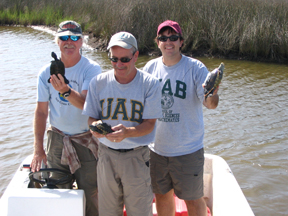The Diamondback Terrapin turtle has become a passion for UAB’s Thane Wibbels, Ph.D., who has studied the unique aquatic animal along with fellow marine biologist Ken Marion, Ph.D., for the past six years.
Wibbels can fire off fact after fact on the terrapin — now considered to be a protected species of the highest conservation concern — and its special relationship with Alabama.
 |
| UAB marine biologists Ken Marion and Thane Wibbels and graduate student Andy Coleman (right) will be returning to the Gulf soon along with graduate student Taylor Roberge to assess the health of the Diamondback Terrapins this year. They also will release 75 of the 150 turtles they have raised in captivity during the past two years. |
In the late 1800s, Alabama had the world’s largest terrapin farm. It shipped 12,000 turtles a year by rail to Savannah, Ga., where they were loaded on a steam ship and sent to the northeast for Terrapin stew, a top delicacy of the times.
Business was so profitable that there was a five-cent terrapin tax levied by the state on each turtle harvested — a tax still on the books “But I don’t think anybody has collected it in probably 50 years,” Wibbels says.
But ask Wibbels about the Diamondback Terrapin now and there are few facts — only hope that the endangered species he and Marion have worked to protect and nurture along the Alabama Gulf Coast have made it unscathed through the 2010 Gulf oil spill.
“How long will it take to know if they’re OK? That I’m not sure,” Wibbels says.
Wibbels and Marion were among nine UAB researchers who recently received a grant from the Alabama’s Marine Environmental Science Consortium for immediate study of the effect of the BP Deepwater Horizon Oil Spill in the Gulf of Mexico on April 20, 2010.
BP has committed up to $500 million to the Gulf Research Initiative Open Research Program to study its response to the oil spill and the effect on the environment and public health. Wibbels and Marion were awarded almost $35,000 to assess the effect of the spill on the tope carnivore and keystone species in the salt marshes of Alabama. They will work in a consortium with other collaborators throughout the northern Gulf of Mexico to complete a long-term assessment of the turtles.
Swift reaction by the state after the oil spill has given Wibbels hope that the Diamondback Terrapins will thrive.
“In Alabama there were instances of oil getting into the bay, but nothing like Louisiana, where they also have a Diamondback Terrapin population,” Wibbels says. “It was completely inundated with oil. Periodically we had oil wash ashore and up into Mobile Bay and Bayou La Batre — the mousy looking stuff — but Alabama reacted quickly enough to get the booms out that the marsh areas were protected. I don’t think you saw an acute destruction of habitat. I’m hoping that Alabama weathers it well. That is going to be something for us to decipher.”
Part of the concern is the potential adverse effect on the turtles’ food chain.
“If the oil that was in the water was taken up by the various animals and moved through the food chain, we need to know if that is something that could be deleterious to the turtles over time,” Wibbels says.
Wibbels, Marion and graduate students Andy Coleman and Taylor Roberge will assess reproduction in the turtles this year and compare their findings to this past year. They plan to look at the turtle eggs and see if they have any accumulations of hydrocarbons or other toxins.
They will also assess the amount of oil in the tissues of the turtles by taking blood samples.
Wibbels, Marion and Coleman will be returning to the Gulf soon to release 75 of the 150 turtles they have raised in captivity the past two years. They had planned to release them this past spring but didn’t because of the oil spill. They will continue to raise the remaining 75 through the summer and release them in late summer or early fall.
“We’ll learn more this spring and summer. We’ll be monitoring the nesting on the nesting beach, and we’ll be going up and down the channels to catch some of our turtles — the ones we’ve tagged,” Wibbels says. “We’ll see if they’ve grown and check their overall status compared to when we last caught them. Our goal is to assess that during the next several years. We’ll just have to wait and see what we find.”
